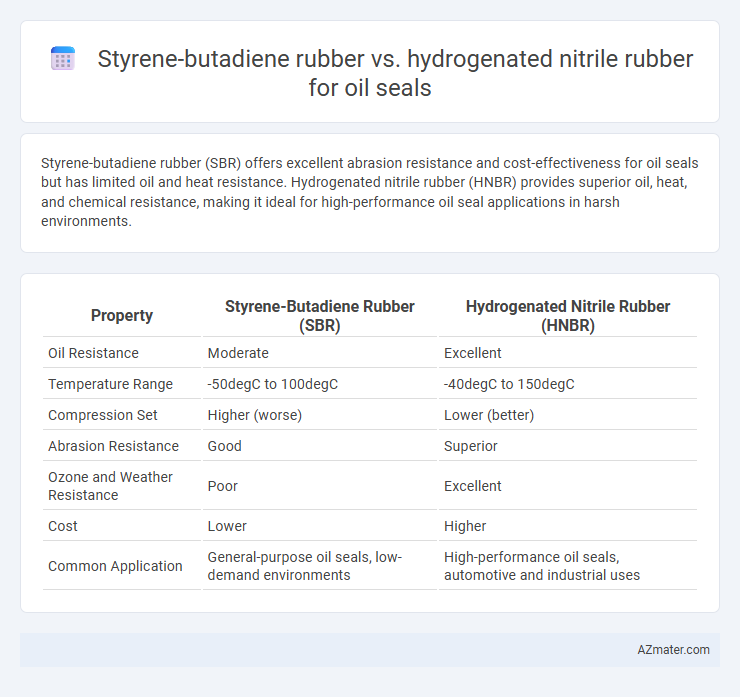Styrene-butadiene rubber (SBR) offers excellent abrasion resistance and cost-effectiveness for oil seals but has limited oil and heat resistance. Hydrogenated nitrile rubber (HNBR) provides superior oil, heat, and chemical resistance, making it ideal for high-performance oil seal applications in harsh environments.
Table of Comparison
| Property | Styrene-Butadiene Rubber (SBR) | Hydrogenated Nitrile Rubber (HNBR) |
|---|---|---|
| Oil Resistance | Moderate | Excellent |
| Temperature Range | -50degC to 100degC | -40degC to 150degC |
| Compression Set | Higher (worse) | Lower (better) |
| Abrasion Resistance | Good | Superior |
| Ozone and Weather Resistance | Poor | Excellent |
| Cost | Lower | Higher |
| Common Application | General-purpose oil seals, low-demand environments | High-performance oil seals, automotive and industrial uses |
Introduction to Oil Seal Materials
Styrene-butadiene rubber (SBR) offers good abrasion resistance and affordability, making it suitable for general-purpose oil seals in moderate temperature and chemical environments. Hydrogenated nitrile rubber (HNBR) provides superior oil, heat, and chemical resistance with enhanced mechanical properties, ideal for demanding applications like automotive and industrial oil seals exposed to high temperatures and aggressive fluids. Selecting the appropriate oil seal material depends on factors such as temperature range, fluid compatibility, and mechanical stress to ensure reliability and longevity.
Overview of Styrene-Butadiene Rubber (SBR)
Styrene-Butadiene Rubber (SBR) is a synthetic elastomer widely used in oil seal applications due to its excellent abrasion resistance and moderate oil resistance. Its polymer structure combines styrene for strength and butadiene for flexibility, making it suitable for dynamic sealing environments with temperatures typically ranging from -50degC to 100degC. SBR's cost-effectiveness and good performance in dry and mildly oily environments distinguish it from more specialized elastomers like Hydrogenated Nitrile Rubber (HNBR), which offers superior chemical resistance and higher temperature tolerance.
Properties of SBR for Oil Seal Applications
Styrene-butadiene rubber (SBR) exhibits excellent abrasion resistance and good aging properties, making it suitable for oil seal applications where mechanical durability is crucial. Its moderate oil resistance allows effective sealing in low to moderate hydrocarbon exposure conditions, while maintaining flexibility at low temperatures down to -50degC. SBR's balance of tensile strength and elasticity ensures reliable sealing performance in dynamic environments with moderate temperature and chemical exposure.
Overview of Hydrogenated Nitrile Rubber (HNBR)
Hydrogenated Nitrile Rubber (HNBR) offers superior chemical resistance and enhanced thermal stability compared to Styrene-butadiene rubber (SBR), making it ideal for demanding oil seal applications. HNBR maintains elasticity and performance in temperatures ranging from -40degC to 150degC, resisting degradation from oils, fuels, and ozone exposure. Its hydrogenation process significantly improves resistance to heat, oxidation, and mechanical wear, ensuring longer service life in automotive and industrial sealing environments.
Properties of HNBR for Oil Seal Applications
Hydrogenated nitrile rubber (HNBR) offers superior resistance to heat, oil, and chemicals compared to styrene-butadiene rubber (SBR), making it highly suitable for demanding oil seal applications. Its excellent tensile strength, low compression set, and outstanding abrasion resistance ensure prolonged durability and effective sealing in harsh environments. HNBR's enhanced thermal stability up to 150degC and resistance to swelling in aggressive fluids significantly improve performance and lifespan of oil seals in automotive and industrial machinery.
Chemical Resistance Comparison: SBR vs HNBR
Hydrogenated nitrile rubber (HNBR) exhibits superior chemical resistance compared to styrene-butadiene rubber (SBR), particularly against oils, fuels, and various hydrocarbons, making it highly suitable for oil seal applications exposed to harsh chemical environments. SBR demonstrates moderate resistance but tends to degrade more quickly when in contact with petroleum-based fluids, limiting its effectiveness in aggressive oil sealing conditions. The enhanced saturation in HNBR's polymer structure drastically improves its resistance to oxidation, heat, and chemical attack, ensuring longer seal life and reliability.
Temperature Performance: SBR vs HNBR
Styrene-butadiene rubber (SBR) exhibits a limited temperature range, typically performing effectively between -50degC to 100degC, which restricts its use in high-temperature oil seal applications. In contrast, hydrogenated nitrile rubber (HNBR) offers superior thermal stability, withstanding continuous temperatures up to 150degC and intermittent spikes reaching 165degC, making it more suitable for demanding oil seal environments. The enhanced temperature tolerance of HNBR results from its hydrogenated molecular structure, providing improved resistance to heat, oxidation, and aging compared to SBR.
Durability and Longevity in Oil Seals
Styrene-butadiene rubber (SBR) offers moderate oil resistance and durability but tends to degrade faster under high-temperature and aggressive oil environments, reducing its longevity in oil seals. Hydrogenated nitrile rubber (HNBR) exhibits superior resistance to heat, oil, and chemical exposure, significantly enhancing durability and lifespan in demanding sealing applications. HNBR's molecular structure provides enhanced mechanical strength and resistance to swelling, making it the preferred choice for oil seals requiring extended service life and reliable performance.
Cost and Availability Considerations
Styrene-butadiene rubber (SBR) offers a cost-effective solution with wide availability due to its established manufacturing processes and abundant raw materials. Hydrogenated nitrile rubber (HNBR) generally incurs higher costs because of its superior chemical resistance and more complex hydrogenation process, which limits broad accessibility. For oil seal applications, SBR is favored when budget constraints and readily available supply are prioritized, whereas HNBR is preferred for demanding environments despite its increased cost.
Conclusion: Best Choice for Oil Seal Applications
Styrene-butadiene rubber (SBR) offers cost-effective performance with good abrasion resistance but limited oil and chemical resistance, making it less ideal for demanding oil seal applications. Hydrogenated nitrile rubber (HNBR) excels with superior heat resistance, excellent oil and chemical stability, and exceptional mechanical properties, ensuring longer service life under harsh conditions. HNBR is the best choice for oil seals requiring durability, reliability, and resistance to extreme temperatures and aggressive fluids.

Infographic: Styrene-butadiene rubber vs Hydrogenated nitrile rubber for Oil seal
 azmater.com
azmater.com